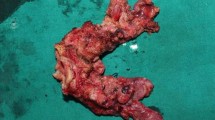Abstract
We describe the operative technique of robotic-assisted laparoscopic radical parametrectomy and analyze perioperative data including adequacy of resections, pathology, and complications in our initial cases. A retrospective study was performed of seven patients with gynecological cancers involving the cervix who had previously been treated with simple hysterectomies and then underwent robotic-assisted radical parametrectomies. Pathology from the initial hysterectomies and the radical parametrectomies was reviewed. Postoperative complications, operative times, estimated blood loss, and length of hospital stay were assessed. The upper part of the vagina, parametrial tissue, and bilateral pelvic lymph nodes of all seven patients who had undergone a previous simple hysterectomy were removed. The mean age was 56.4 (SD ± 10.7) years. Diagnoses from hysterectomy specimens were invasive squamous carcinoma (n = 4), endometrial adenocarcinoma (n = 2), and clear-cell papillary adenocystic cervical carcinoma (n = 1). The median number of lymph nodes removed was 8 (min 4, max 29), and one patient had nodal metastasis. The mean operative time was 228.6 (SD ± 38.9) min, estimated blood loss was 147 (SD ± 58.2) ml, and length of hospital stay was five (SD ± 2.3) days. One intraoperative complication (cystotomy) occurred and was successfully repaired. One postoperative fistula developed on postoperative day 10. This early experience demonstrates that the basic surgical and anatomical principles of radical parametrectomy can be applied to robotic-assisted laparoscopic surgery. Genitourinary fistulae are always a concern with this procedure, and minimization of electrocautery near the bladder and ureters may further reduce complications.



Similar content being viewed by others

References
Piver MS, Rutledge F, Smith JP (1974) Five classes of extended hysterectomy for women with cervical cancer. Obstet Gynecol 44:265–272
Zapardiel I, Zanagnolo V, Magrina JF, Magtibay PM (2010) Robotic radical parametrectomy in benign disease: report of two cases. Acta Obstet Gynecol Scand 89:1108–1110
Orr JW Jr, Ball GC, Soong SJ, Hatch KD, Partridge EF, Austin JM (1986) Surgical treatment of women found to have invasive cervix cancer at the time of total hysterectomy. Obstet Gynecol 68:353–356
Ayhan A, Kucukoskan T, Tuncel ZS (1992) Management of invasive cervical cancer in patients initially initially treated by simple hysterectomy. Eur J Surg Oncol 18:177–179
Fujii S (2008) Anatomic identification of nerve-sparing hysterectomy: a step-by-step procedure. Gynecol Oncol 111:S33–S41
Charoenkwan K, Srisomboon J, Suprasert P, Tantipalakorn C, Kietpeerakool C (2006) Nerve-sparing class III radical hysterectomy: a modified technique to spare the pelvic autonomic nerves without compromising radicality. Int J Gynecol Cancer 16:1705–1712
Magrina JF, Walter AJ, Schild SE (1999) Laparoscopic radical parametrectomy and pelvic and aortic lymphadenectomy for vaginal carcinoma: a case report. Gynecol Oncol 75(3):514–516
Liang Z, Xu H, Chen Y, Li Y, Chang Q, Shi C (2006) Laparoscopic radical trachelectomy or parametrectomy and pelvic and para-aortic lymphadenectomy for cervical or vaginal stump carcinoma: report of six cases. Int J Gynecol Cancer 16(4):1713–1716
Fleisch MC, Hatch KD (2005) Laparoscopic assisted parametrectomy/upper vaginectomy (LPUV)—technique, applications and results. Gynecol Oncol 98:420–426
Magrina JF, Magtibay PM (2012) Robotic nerve-sparing radical parametrectomy: feasibility and technique. Int J Med Robot 8:206–209
Yabuki Y, Asamoto A, Hoshiba T, Nishimoto H, Nishikawa Y, Nakajima T (2000) Radical hysterectomy: an anatomic evaluation of parametrial dissection. Gynecol Oncol 77:155–163
Yabuki Y, Asamoto A, Hoshiba T, Nishimoto H, Satou N (1996) A new proposal for radical hysterectomy. Gynecol Oncol 62:370–378
Wrihght JD, Grigsly PM (2007) Utility of parametrectomy for early stage cervical cancer treated with radical hysterectomy. Cancer 110:1281–1286
Possover M, Stober S, Plaul K, Schneider A (2000) Identification and preservation of the motoric inervation of the bladder in radical hysterectomy type III. Gynecol Oncol 79:154–157
Cibula D, Abu-Rustum NR, Benedetti-Panici P, Koehler C, Raspagliest F, Querleu D, Morrow CP (2011) New classification system of radical hysterectomy: emphasis on a three-dimensional anatomic template for parametrial resection. Gynecol Oncol 122:264–268
Lee CL, Huang KG, Wang CJ, Yen CF, Soong YK (2000) Radical laparoscopic surgery for carcinoma of the cervical stump. J Am Assoc Gynecol Laparosc 7(2):241–244
Köhler C, Tozzi R, Klemm P, Schneider A (2003) “Schauta sine utero”: technique and results of laparoscopic-vaginal radical parametrectomy. Gynecol Oncol 91(2):359–368
Ramirez PT, Schmeler KM, Wolf JK, Brown J, Soliman PT (2008) Robotic radical parametrectomy and pelvic lymphadenectomy in patients with invasive cervical cancer. Gynecol Oncol 111:18–21
Vitobello D, Siesto G, Bulletti C, Accardi A, Iedà N (2012) Robotic radical parametrectomy with pelvic lymphadenectomy: our experience and review of the literature. Eur J Surg Oncol 38:548–554
Holloway RW, Ahmad S (2012) Robotic-assisted surgery in the management of endometrial cancer. J Obstet Gynaecol Res 38:1–8
Frey MK, Worley MJ Jr, Slomovitz BM (2011) Robotic radical parametrectomy for unstaged invasive endometrial carcinoma. Int J Gynaecol Obstet 115(2):208–209
Magrina JF, Zanagnolo VL (2008) Robotic surgery for cervical cancer. Yonsei Med J 49(6):879–885
Persson J, Kannisto P, Bossmar T (2008) Robot-assisted abdominal laparoscopic radical trachelectomy. Gynecol Oncol 111(3):564–567
Shafer A, Boggess JF (2008) Robotic-assisted endometrial cancer staging and radical hysterectomy with the da Vinci surgical system. Gynecol Oncol 111(2 Suppl):S18–S23
National Health Insurance Fund of Bulgaria. http://www.nhif.bg/web/guest/170. Accessed 11 Nov 2012
Conflict of interest
None disclosed.
Author information
Authors and Affiliations
Corresponding author
Rights and permissions
About this article
Cite this article
Gorchev, G.A., Tomov, S.T., Radionova, Z.V. et al. Robotic-assisted radical parametrectomy in patients with malignant gynecological tumors. J Robotic Surg 7, 317–323 (2013). https://doi.org/10.1007/s11701-012-0387-7
Received:
Accepted:
Published:
Issue Date:
DOI: https://doi.org/10.1007/s11701-012-0387-7



